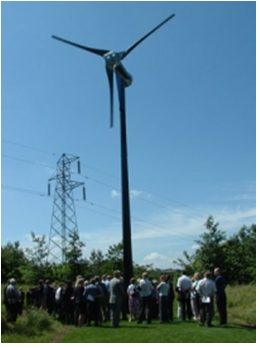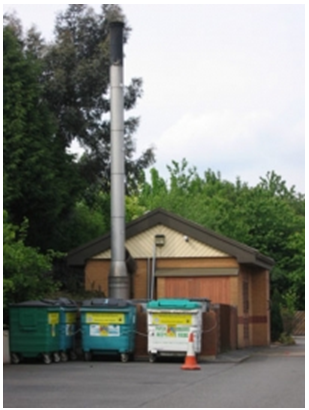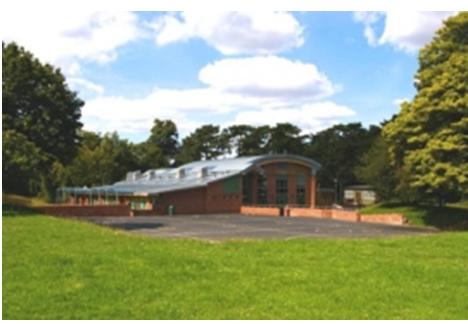외국
Carbon management in Kirklees schools
Pupil-led wind turbine project at Spen Valley Sports College

Carbon management in Kirklees schools
Contributed by:
Sustainable Development Commission
| Kirklees, North East |
Organisation:
We are a non-departmental public body
Publication of any case study does not imply an endorsement of its merit by the Sustainable Development Commission.
An innovative scheme introduced by Kirklees Council is enabling it to invest in energy and water efficiency measures in its estate and to attract external funding for energy projects. The scheme is known as the Energy and Water Conservation Fund.
Overview
Kirklees’ 198 school buildings emit about 19,000 tonnes of CO2 per year – about half of the authority’s estates estimated total of 37,000 tonnes. An innovative scheme introduced by Kirklees Council is enabling it to invest in energy and water efficiency measures in its estate and to attract external funding for energy projects. The scheme is known as the Energy and Water Conservation Fund.
Any council building (including schools) can request an energy survey containing costed recommendations on investments to save energy and water and reduce bills. Building managers can then apply for a loan from the fund to carry out the work on the assumption that it will be repaid from the savings arising from lower energy and water bills. Annual repayments are set at half the value of the savings so that even during the repayment period the recipient of the loan saves money. Payments continue until the grant has been repaid, and then for a further two years as a contribution towards the fund’s administrative costs. For small projects under £1,000, half of the cost of the project is given as a grant.
Before work begins, applicants supply details about their current energy and water consumption, floor area, hours and times of use, number of occupants and any additional information about activities with energy and water implications (e.g. swimming pool). These are then re-measured after the relevant investments have been made to ensure the impact of the work is properly assessed.
Energy and water consumption reports are also produced each year for council buildings, comparing the previous year’s usage with a three-year average and national benchmarks. The aim is to enable staff to regularly take stock of their energy usage and carbon emissions in order to plan for further reductions.
To date, 60 per cent of applications to the fund have been from schools. The authority believes that energy efficiency education is crucial and recognises that the 65,000 pupils in Kirklees schools are the energy managers of its future low-carbon economy. Each year, around 10 -15 local schools are selected to take part in a Climate Champions project. Schools are chosen to reflect different age groups, different areas of Kirklees, different socio-economic backgrounds, and where there are recognised issues with energy usage.
Key features
education
energy
Key data
Project Team:
Local Authority:
Wood heat in Nottinghamshire schools
Mornington Primary School boiler house

Wood heat in Nottinghamshire schools | Nottingham, North East |
Contributed by:Sustainable Development Commission
Organisation:We are a non-departmental public body
Publication of any case study does not imply an endorsement of its merit by the Sustainable Development Commission.
To date 30 boilers have been installed at 25 schools, at a cost of almost £1.4m. These, and a further 18 installations planned over the next year, will reduce CO2 emissions by a total of 4,343 tonnes per year, which is almost 10 per cent of schools’ emissions in the county.
Overview
Schools account for over 57 per cent of all carbon emissions from Nottinghamshire County Council’s estate, with many using coal-fired heating systems – a legacy from the county’s coal mining heritage. In 2003 the authority began replacing coal with wood-fuel by installing new boilers or converting existing coal-fired boilers to handle wood pellets. To date 30 boilers have been installed at 25 schools, at a cost of almost £1.4m. These, and a further 18 installations planned over the next year, will reduce CO2 emissions by a total of 4,343 tonnes per year, which is almost 10 per cent of schools’ emissions in the county.
The results speak for themselves. West Bridgford School recently achieved an A grade rating on its Display Energy Certificate (DEC), where a rating for a building like this would normally range from D to E. In 2005 the school converted its old coal-fired boilers to run on 100 per cent renewable biomass as part of the Wood-heat initiative. The whole of the pool and theatre block, including the water for the swimming pool, hot water for showers and several other smaller buildings are now heated solely by biomass boilers. Since conversion over 2,000 tonnes of carbon emissions have been saved, and the student council is committed to achieving Eco-School status.
Nottinghamshire’s wood-heat programme represents a clear commitment by the authority to tackling the causes of climate change, something enshrined in the Nottingham Declaration on Climate Change to which it is a signatory. It is a key component of the authority’s carbon management plan, and positively supports progress with the two climate change indicators (NI185 and NI 186) featured in the new Local Government Performance Framework.
Schools and pupils are enthusiastic about the use of wood-fuel. They are keen on the environmental benefits and primary schools in particular are using their wood-fuel boilers to inspire learning about sustainability and climate change. The programme also builds confidence in wood-heat within the region and has led to a local wood-heat infrastructure developing; much of the wood is grown locally and two pellet mills have been built within the county providing the beginnings of a new industry for Nottinghamshire and a potential new revenue stream for local landowners. The clear lesson is that tackling climate change can provide important spin-off opportunities for local economic development and education.
Key features
education
energy
Learning for sustainability in
Worcestershire schools
Red Hill Primary School’s climate-proofed building
Learning for sustainability in Worcestershire schools

Contributed by:Sustainable Development Commission
Organisation:We are a non-departmental public body
Learning for sustainability in Worcestershire schools | , North East |
Publication of any case study does not imply an endorsement of its merit by the Sustainable Development Commission.
Worcestershire County Council (WCC) sees educating the next generation about sustainable development as a crucial role for schools, and has run an internationally respected Education for Sustainable Development (ESD) service for many years.
Overview
Worcestershire County Council (WCC) sees educating the next generation about sustainable development as a crucial role for schools, and has run an internationally respected Education for Sustainable Development (ESD) service for many years.
Over the last two years, the ESD Team have coordinated a County Learning for Sustainability Forum which brings together officers from County Council Directorates, District Councils, local NGOs and others supporting schools with their work to become sustainable schools. The Forum recently had its Learning for Sustainability Strategy approved by the Worcestershire Partnership (a local strategic partnership), and this endorsement strengthens the Forum’s role in building partnerships for action on sustainable schools. Climate change is a named key theme running through the Strategy.
Over the past three years, the authority has worked with Warwickshire County Council and Coventry City Council on a Switch it Off campaign that is linked to its work on climate change with schools. The campaign is delivered through a two-week programme. The first week involves ‘under-cover’ audits and checks by a pupil-led eco team, leading to a general awareness raising about the issues and possible solutions. The second week is ‘Switch it Off Week’, with a focus on actively reducing energy use. Schools have reported varying degrees of success, with some cutting electricity consumption by a third and one school by 50 per cent. The campaign is a part of a joined-up approach to encouraging schools to focus on energy across curriculum, campus and community, not just as a one off, but as an ongoing theme and tied in with monitoring and evaluation as part of Eco-Schools. It has led to much greater awareness of the benefits of monitoring and reducing energy use in schools, including the potential cost savings.
The ESD service is active in thinking through how climate change can be addressed through the design and construction of school buildings. Its strong links with the Council’s architecture unit have influenced the design of schools in the county, a good example of which is Red Hill first school in Worcester.
Designed as a ‘climate change ready’ school, Red Hill was one of the first in the UK to use the UKCIP climate change adaptation framework to inform the design process, leading to a low–profile roofline with wide guttering, shade-giving overhangs, a sustainable drainage scheme (SUDS) and solar-powered ventilation stacks. It was opened by the minister for climate change on 18th June 2007 and acts as a test bed for technologies to be used elsewhere in the County.
The building has a variety of features that reduce its carbon footprint and enhance the overall environment of the site. It is the first school in the County with ground source heating and hot water systems. It harvests rainwater for flushing toilets and has a mechanical extract ventilation system powered by small photovoltaic panels. The ICT suite is cooled in summer using the ground source heat pump in reverse mode, while the sustainable drainage system provides includes a rich wildlife habitat and recreation/learning area based on swales and ponds. Much of the original building was crushed on site to create hardcore for the new foundations, and extensive use was made of recycled content materials in the construction.
Key features
education
energy
게시물수정
게시물 수정을 위해 비밀번호를 입력해주세요.
댓글삭제게시물삭제
게시물 삭제를 위해 비밀번호를 입력해주세요.






